Eve Lazarus's Blog: Every Place has a Story, page 36
March 3, 2018
Emily Carr’s James Bay
Emily Carr died on March 2, 1945, and since March 8 is International Women’s Day, it seems fitting to write a blog about this famous artist and take you on a tour of her James Bay neighbourhood. The tour is laid out in much more detail and accompanied by then and now photos in Sensational Victoria.
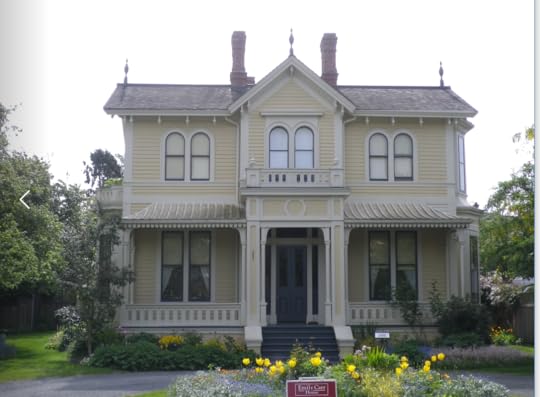 More than 12,000 people visit Emily Carr House every year. Eve Lazarus photo, 2011
More than 12,000 people visit Emily Carr House every year. Eve Lazarus photo, 2011Her name adorns a university, a school, a bridge, and a library. She is the subject of several documentaries, museum exhibits, books and plays. In 2009, her painting Wind in the Tree Tops sold for more than $2.1 million, one of the highest-priced Canadian paintings ever sold at auction. Tourists visit her family home, seek out her sketching places along Dallas Road and Beacon Hill Park and walk over the memorial bridge paid for by her sister Alice. Her grave is the most sought-after in the Ross Bay Cemetery.
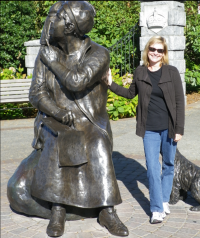 Emily Carr’s presence in Victoria is pervasive. Yet for most of her life, she was shunned by the Victoria of her day, and for all of her fame, locals still seem a bit stunned by the attention. It wasn’t until the fall of 2010—65 years after her death—that Victoria honoured the artist with a $400,000 statue on the lawn of the Fairmont Empress Hotel.
Emily Carr’s presence in Victoria is pervasive. Yet for most of her life, she was shunned by the Victoria of her day, and for all of her fame, locals still seem a bit stunned by the attention. It wasn’t until the fall of 2010—65 years after her death—that Victoria honoured the artist with a $400,000 statue on the lawn of the Fairmont Empress Hotel.
Emily was born at Carr House in 1871, and died a few blocks away at the James Bay Inn, 74 years later. For most of her life, she lived in James Bay and wrote extensively about the area and her family’s homes.
James Bay is the oldest residential area of Victoria and takes its name from Governor James Douglas. Douglas built his house in the 1850s on the current site of the Royal BC Museum. Dr. John Sebastian Helmcken married Douglas’s daughter and built his house next door. His house is still there and is now a provincial museum.
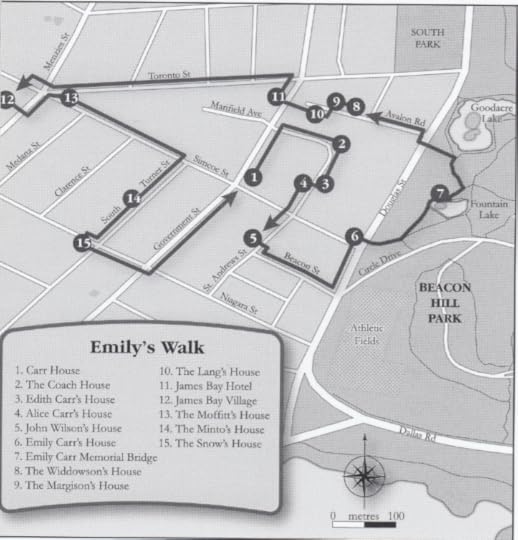 Map of James Bay walking tour created for Sensational Victoria by Ross Nelson, 2012
Map of James Bay walking tour created for Sensational Victoria by Ross Nelson, 2012Until a causeway was completed in the early 1900s, Government Street was made up of Carr Street (named after Emily’s father Richard), Birdcage Walk, and the James Bay Bridge—a wooden bridge that crossed the mud flats and continued downtown.
In 1908, the James Bay mud flats were hidden underneath the spanking new $13-million Empress Hotel. By the 1940s, houses had taken over all the land. Postwar development hit in the 1950s, and then in the 1960s and ‘70s—as in Vancouver’s West End—many of Victoria’s superb heritage houses were bulldozed to make room for apartment buildings.
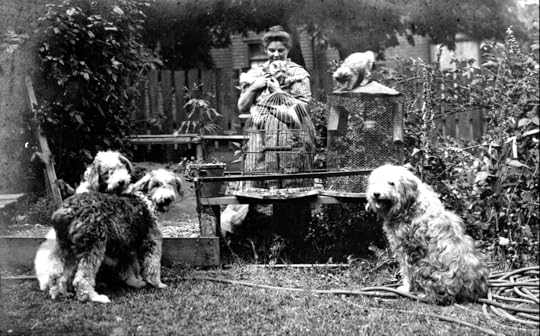 Emily with her animals in 1918. Courtesy Royal BC Museum, BC Archives
Emily with her animals in 1918. Courtesy Royal BC Museum, BC ArchivesYet with all these changes, the Victoria Heritage Foundation still lists over 150 buildings on its heritage inventory, some like Helmcken’s, that date back to the 1850s.
Emily started writing in the late 1920s and had seven books published during her lifetime and after her death. She wrote extensively about James Bay and her family house in The Book of Small, and about how much she hated being a landlady in The house of All Sorts.
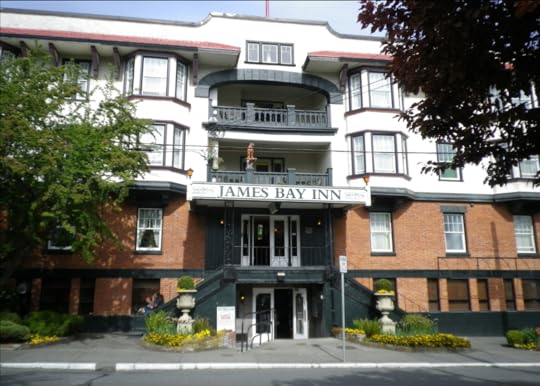 Mother Cecilia bought the hotel in 1942 and ran it as St. Mary’s Priory. Emily died here in 1945. Eve Lazarus photo, 2011
Mother Cecilia bought the hotel in 1942 and ran it as St. Mary’s Priory. Emily died here in 1945. Eve Lazarus photo, 2011What was great, at least in 2012 when I was putting this tour together, was that most of the houses that involve Emily—including the home where she was born on Government Street, the “House of All Sorts,” known for all the different people who boarded there, two of her sister’s houses, and James Bay Hotel (Inn) built in 1911, are all still there.
So, the next time you’re in the area, grab a copy of Sensational Victoria from Munro’s Books, and take a walk around Emily’s James Bay.
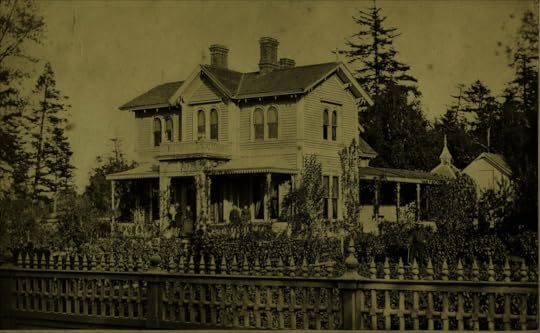 Carr family, 207 Government St, 1869. Courtesy Royal BC Museum, BC Archives
Carr family, 207 Government St, 1869. Courtesy Royal BC Museum, BC Archives© All rights reserved. Unless otherwise indicated, all blog content copyright Eve Lazarus.

February 24, 2018
The shootout at False Creek Flats
On February 26, 1947 Vancouver Police officers Charles Boyes and Oliver Ledingham were murdered in a shootout at False Creek Flats . The officers are remembered in an exhibit at the Vancouver Police Museum that opens March 1, and their stories are part of Blood, Sweat, and Fear.
During the 1940s, many of Vancouver’s young men aged between 13 and 18 were recruited into “hoodlum gangs.” The youth were good at steering clear of police, members were rarely identified, and their crimes became increasingly serious. Police believed that an organized crime ring was recruiting these boys and using them to rob military depots and armouries and then use the stolen guns to rob banks around the Lower Mainland.
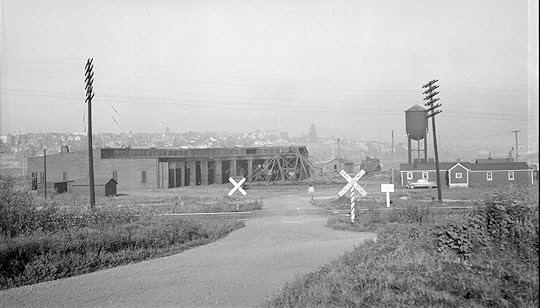 False Creek Flats and the Great Northern Railway Round House in 1956. CVA 447 250
False Creek Flats and the Great Northern Railway Round House in 1956. CVA 447 250On February 26, 1947 three teenagers planned to rob the Royal Bank at Renfrew and First. A 17-year-old boy named William (Fats) Robertson, was upset with his friends for leaving him out of the robbery and tipped off police. Just as the boys were putting on their stocking masks, police rolled up and got into a car chase. It ended with the boys bailing out of the car and trying to lose police in the railyards of False Creek flats.
A gun fight ensured in which officers Ledingham and Boyes were killed, and another officer Percy Hoare, was shot in the leg and shoulder. Badly injured, but still able to shoot, Hoare killed Doug Carter, an 18-year-old with a wife and baby, another hit Harry Medos in the leg.
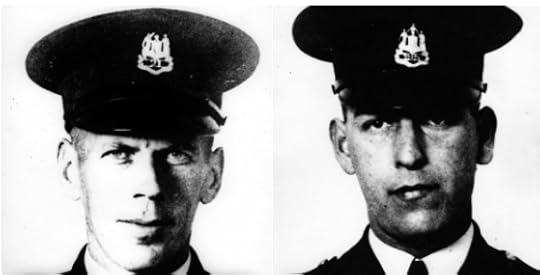 Oliver Ledingham and Charles Boyes. Courtesy Vancouver Police Museum
Oliver Ledingham and Charles Boyes. Courtesy Vancouver Police MuseumThe shootings put Chief Walter Mulligan in a difficult position. Just two days before he had told a Vancouver Sun reporter that the “gloves were off” in a war against city crime. And, as the same newspaper reported, in the next 48 hours Vancouver experienced seven burglaries, two hold ups, two attempted robberies and 19 thefts.
Harry Medos, 18, was executed, while 17-year-old William Henderson received five years for possession of a firearm.
Fats Robertson, who was not invited along on the robbery that day, went on to a spectacular life of crime and a career on the Vancouver Stock Exchange. He was a co-owner of the Wigwam Inn on Indian Arm in the early 1960s and turned it into an illegal gambling operation, printed counterfeit money, and ran a brothel. Eventually he was jailed for trying to bribe an RCMP officer.
 More than 100,000 people attended the funeral for Boyes and Ledingham. VPL 42982
More than 100,000 people attended the funeral for Boyes and Ledingham. VPL 42982Ledingham, 40, who was known in his Kitsilano neighbourhood for his crops of gladioli and tulips, left behind a wife and 13-year-old son. Boyes, 38, who was a wizard with tools and often fixed the toys of the kids in his Point Grey neighbourhood, left behind a wife and six-year-old daughter.
© All rights reserved. Unless otherwise indicated, all blog content copyright Eve Lazarus.

February 17, 2018
$1.49 Day Woodward’s. $1.49 Day Tuesday
Sixty years ago today, CKNW creative director, Tony Antonias wrote the famous Woodward’s $1.49 day jingle.
Antonias, a New Westminster resident and former Aussie—who like most of us ex pats have kept our accents—started as a copywriter at the station in 1955. He stayed there for the next 40 years—to the day.
As Tony tells it, the jingle came about almost by accident after he hit the key on a new typewriter and it made a loud ding. When he hit it again, it made another ding—yup $1.49 Day. Tuesday.
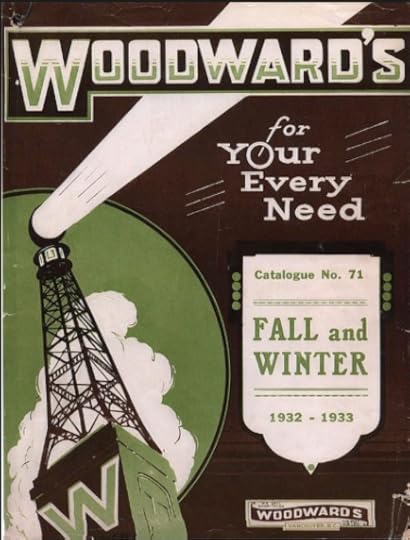
Tony wrote the jingle on February 17, 1958, recorded it on the Easter weekend and heard it go to air in April 1958 “after Woodwards took six weeks to decide to use it.”
“Everybody wants to know how the $1.49 jingle came to be,” he told me. “I’ve scripted it and I’ve got it on CDs and they love hearing it.”
Percival Archibald Woodward (Puggy) ran the Woodwards Department Stores for many years. It was Puggy who created Woodward’s famous food floor—and with it, turned the entire concept of retailing on its head.
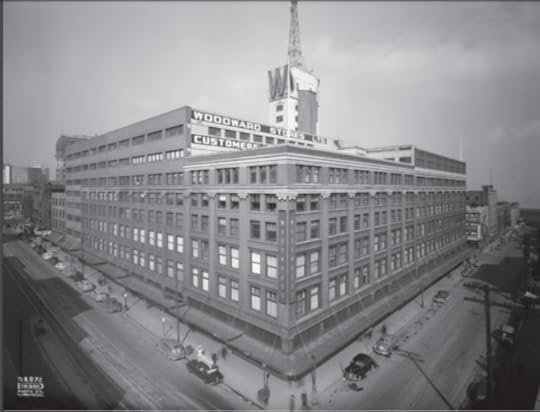 Woodwards ca.1940s. Courtesy VPL 27900
Woodwards ca.1940s. Courtesy VPL 27900And, it was his idea in 1927 to build a 75-foot-high beacon modelled after the Eiffel Tower to act as a giant billboard advertisement for the department store. The tower held a searchlight that threw out a two million candlepower beam which revolved six times each minute and could be seen from Vancouver Island. When the war hit he was told to remove the tower and the 16-foot W took its place. Puggy predicted that malls were the wave of the future and he was a driving force behind the Park Royal Shopping Centre, which in 1950, was the first shopping mall in Canada.
He died in 1968—10 years after Tony created the Woodward’s jingle. Puggy was a huge philanthropist with an interest in medical research and he left his vast estate to the Mr. and Mrs. P.A. Woodwards Foundation where it continues to do great work.
 A Woodwards elevator operator in the 1970s. Photo courtesy Angus McIntyre
A Woodwards elevator operator in the 1970s. Photo courtesy Angus McIntyreIf that jingle and the famous whistle is not firmly wedged in your head for the rest of the day—or if you were born after 1992—you can listen to here on soundcloud
© All rights reserved. Unless otherwise indicated, all blog content copyright Eve Lazarus.

February 10, 2018
Saving History: the life’s work of J.F.C.B. Vance, Vancouver’s first forensic investigator
In July 2016, several large cardboard boxes filled with photographs, clippings, forensic samples, and case notes pre-dating 1950, and thought to be thrown out decades ago, were discovered in a garage on Gabriola Island. They are now with the Vancouver Police Museum and Archives, and form the basis of Blood, Sweat, and Fear: the story of Inspector Vance, Vancouver’s first forensic investigator.
I first “met” Inspector John F.C.B. Vance when I was writing Cold Case Vancouver. He turned up at a crime scene in Chapter 1, the murder of Jennie Eldon Conroy, a 24-year-old war worker who was beaten to death and dumped at the West Vancouver Cemetery. It turned out that Vance wasn’t actually a police officer–he ran the Police Bureau of Science for the Vancouver Police Department, and his cutting-edge work in forensics solved some of the most sensational cases in the first half of the last century.
Unfortunately, Jennie’s wasn’t one of them.
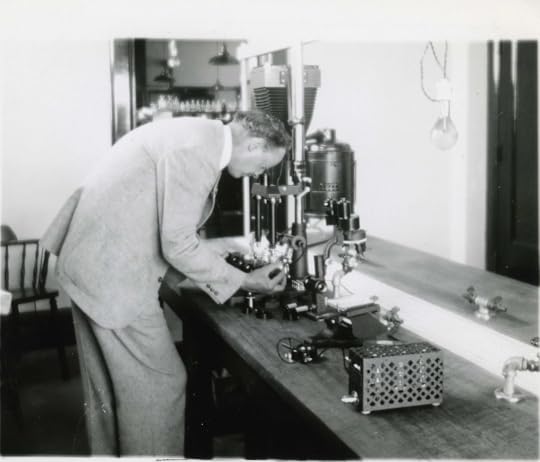 Vance examines a spent bullet through a comparison microscope in 1932. Courtesy Vance family
Vance examines a spent bullet through a comparison microscope in 1932. Courtesy Vance familyFor most of his career, Vance worked out of 240 East Cordova Street, the building that now houses the Vancouver Police Museum. With their help, I was able to track down a couple of Vance’s grandchildren. Janey and David remembered that J.F.C.B.—as Vance was known in the family—had packed up several cardboard boxes full of photographs, clippings, and case notes from dozens of cases when he retired in 1949. He took them with him when he moved in 1960, but no one had seen them for years, and it was thought that they’d been thrown out. And then, in July 2016, more than half a century after Vance’s death, the boxes were found in another grandchild’s garage on Gabriola Island.
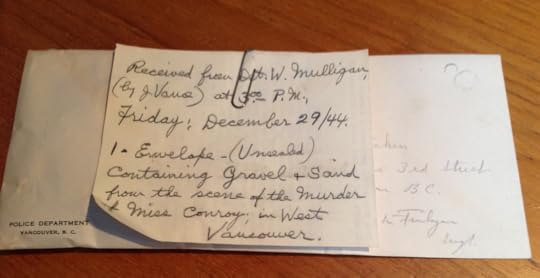 Vancouver was the only police department in Canada that had a forensic scientist on staff and one of the few police departments in North America to use forensics in criminal investigations. Forensic samples found in one of the boxes
Vancouver was the only police department in Canada that had a forensic scientist on staff and one of the few police departments in North America to use forensics in criminal investigations. Forensic samples found in one of the boxesIncredibly, when Janey opened the first box she found a large, tattered envelope labelled Jennie Eldon Conroy murdered West Vancouver, Dec 28, 1944. Inside there were smaller envelopes marked with the VPD insignia and filled with hair and gravel samples from the crime scene, an autopsy report, crime scene photos, and several newspaper clippings.
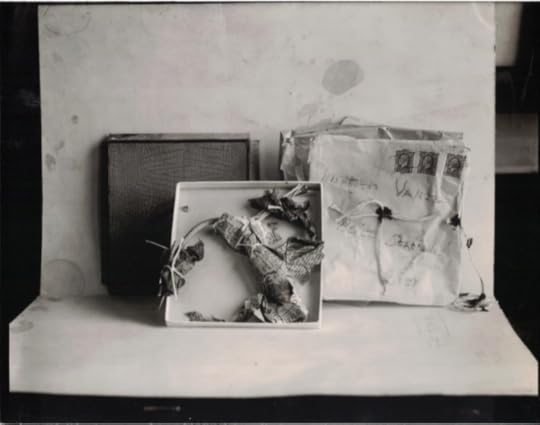 Vance’s science was so successful that in 1934 there were seven attempts on his life. This was a home made bomb sent to Vance’s lab through the general police mail
Vance’s science was so successful that in 1934 there were seven attempts on his life. This was a home made bomb sent to Vance’s lab through the general police mailVance was skilled in serology, toxicology, ballistics, trace evidence and autopsy. He was a familiar face at crime scenes and in the courtroom, and was called the Sherlock Holmes of Canada by the international media. Yet few people have heard of him.
Hopefully that will change with the publication of Blood, Sweat, and Fear, but best of all, all those boxes, the crime scene photos, the case notes, even Vance’s personal diary, are now with the Vancouver Police Museum and Archives. They’ll be properly processed, cared for, and eventually made available to the public.
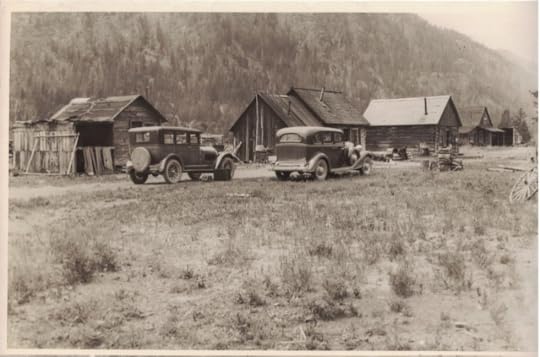 Crime scene photo from the murder of two police officers in Merritt, BC in 1934.
Crime scene photo from the murder of two police officers in Merritt, BC in 1934. Excited to be taking part in a few events coming up in Vancouver and on the North Shore. I’ll be talking about some of the murders from Blood, Sweat, and Fear; Vancouver’s role in the development of forensics; and of course, our city’s criminal past.
© All rights reserved. Unless otherwise indicated, all blog content copyright Eve Lazarus.

February 3, 2018
Fifty Years Ago: Vancouver International Airport
On February 7, 1968 a Canadian Pacific Airlines flight from Honolulu was on final descent into Vancouver when it hit a small fog patch just above the runway. The Boeing 707 touched down, swerved out of control and smashed through light planes, trucks and a workshop before crashing into a concrete building. Martinus Verhoef, a 33-year-old flight attendant from West Vancouver was crushed to death in the buckled fuselage near the front of the plane, and Elmer Nedcalf, a 44-year-old airport employee from Richmond died in the wreckage from the workshop.
All sixty passengers and crew survived.
 Thanks to Angus McIntyre for passing along this photo that was published by the Greater Vancouver Real Estate Board in 1969. The caption read: “A modern jet-age terminal opened on Sea Island. Giant boarding arms reach out to serve air-age travellers to all domestic points and exotic foreign centres around the world.”
Thanks to Angus McIntyre for passing along this photo that was published by the Greater Vancouver Real Estate Board in 1969. The caption read: “A modern jet-age terminal opened on Sea Island. Giant boarding arms reach out to serve air-age travellers to all domestic points and exotic foreign centres around the world.”This was the first crash at the airport involving a major aircraft and a rough start to the year for YVR.
It was also the same year that the airport opened a new terminal building designed by local architect Zoltan Kiss to handle all domestic, US and international flights. It was one of the few airports where aircraft could pull up to gates attached to the terminal and where passengers could load and unload via a bridge.
 A recent view of YVR, courtesy Angus McIntyre
A recent view of YVR, courtesy Angus McIntyreKiss worked for Thompson Berwick Pratt, the firm that served as an incubator for such other up-and-comers as Arthur Erickson, Ron Thom, Barry Downs and Fred Hollingsworth.
If you’ve taken a plane from Vancouver to any other point in Canada—you’ve walked through this terminal. You’ve also likely noticed the two large air-intake towers that flank it. These concrete towers were an engineering feat back in 1968 and replaced the old system which had the air intake in the roof. When the wind would blow the wrong way, employees and passengers would complain about the overpowering smell of aviation fuel.
 YVR in 1967. Photo courtesy Vancouver Airport Authority (air-intake tower at left of frame)
YVR in 1967. Photo courtesy Vancouver Airport Authority (air-intake tower at left of frame)YVR officially opened in 1931 when the City of Vancouver invested $600,000 in a runway and a small wood framed building topped by a control tower after US aviator Charles Lindbergh refused to visit because there was “nothing fit to land on.”
Big changes happened in the ‘60s after the City sold the Airport to the Department of Transport. By 1968 the airport sat on more than 4,000 acres of land, and the spanking new terminal building served close to two million passengers in its first year of operation.*
 “I remember how large and modern it was compared to the old (now South) terminals. You could drive your car up to the departure level, park and pay 25 cents at a meter,” says Angus McIntyre. Photo courtesy Vancouver Airport Authority.
“I remember how large and modern it was compared to the old (now South) terminals. You could drive your car up to the departure level, park and pay 25 cents at a meter,” says Angus McIntyre. Photo courtesy Vancouver Airport Authority.Half a century later, more than 24 million passengers pass through YVR.
And, while air travel today generally sucks, the good news is that not one person died in an accident on a commercial passenger jet last year —making 2017 the safest year ever.
 Before and after. Photo courtesy Vancouver Airport Authority
Before and after. Photo courtesy Vancouver Airport Authority*see SFU: The history of Vancouver International Airport
© All rights reserved. Unless otherwise indicated, all blog content copyright Eve Lazarus.

January 27, 2018
Saving History: the autographed lights from the Orpheum Theatre
A couple of weeks ago Bill Allman, Tom Carter and I were sipping martinis and discussing bits of history that have been saved from the dumpster. The subject of the rescued lights from the Orpheum Theatre came up, and next thing he knew, Bill had agreed to write this blog.
By Bill Allman
Deep in a haunted basement on West Cordova, below Vancouver curio shop, Salmagundi West, lay a collection of vintage stage lights. I blew the dust off one marked TUTS (for
 Tom Carter and Bill Allman, 2017
Tom Carter and Bill Allman, 2017Theatre Under the Stars) and marveled at the antique design. “There are more.” said my friend – theatre historian and painter extraordinaire, Tom Carter. “Where?” I asked. “The Orpheum. A whole collection. All signed by different stars.”
I let out a low whistle. We emerged from the cavernous cellar, went to the Sylvia Hotel for a drink (or three), and decided that we HAD to see the Orpheum’s treasure trove.
Tom and I were organizing a gala fundraiser and auction for the Friends of the Vancouver Archives to benefit the Hugh Pickett Collection. But that’s another story. This one is about lights – stage lights that had illuminated shows for hundreds of thousands of people.
I am fascinated by objects from great performances by famous people. “Screen used” props, and dog-eared shooting scripts are the only ones I care about; likewise, any piece of stage memorabilia with a genuine connection to a gifted artist. So, when we got access to the Orpheum’s cache of autographed lights, AND a very generous donation from the B.C. Entertainment Hall of Fame of three of those lights for our auction, we were in seventh heaven.
 Three lights went up for auction at the Hugh Pickett Gala in November 2017. Courtesy Christina Potter
Three lights went up for auction at the Hugh Pickett Gala in November 2017. Courtesy Christina PotterThere we were, crouched in a room in the Orpheum hidden from public view and illuminated only by a flickering Radio Shack strobe light bouncing off the walls and the tinsel curtain that covered the racks of antique Leko lights. As quickly as we could read the names, we’d call them out with schoolyard excitement. “Tina Turner!”, “Michael Buble!”, “Ray Charles!”. Then we found the three we wanted for the auction – artists that Hugh had presented at one time or another: “Tony Bennett!”, “Victor Borge!”, “And here’s a friend of mine – Jeff Hyslop!”
 A light signed by Tony Bennett after a performance at the Orpheum. Courtesy Jason Vanderhill
A light signed by Tony Bennett after a performance at the Orpheum. Courtesy Jason VanderhillThe lights had almost been lost to time and the dumpster. Another near-tragedy of Vancouver’s urge to purge its past. But eyes that were keen and hearts that long to preserve and celebrate our city’s culture had intervened. The three lights that sold went to homes where their rich history would be appreciated. And the remainder? They rest in a secret room in a famous theatre. And the day will come when they are displayed and perhaps even researched by top people.
Who?
Top people.
Bill Allman is a “recovering lawyer” and instructor of Entertainment Law at UBC. Bill has been a theatre manager (the Vogue), president of Theatre Under the Stars, and a concert promoter and theatre producer through his company, Famous Artists Limited. He is no longer willing to move your piano.

January 20, 2018
Vancouver Archives Receives Two Million Negs
City archivist Heather Gordon says the recent donation of a whopping two million negatives from the Sun and Province (Postmedia) photo library is the largest photographic collection that Vancouver Archives has ever received. It’s also one of the most important.
 Heather Gordon shows off a recent donation from the Vancouver Sun and Province. “The information in the accompanying card index and on the envelopes—is fantastically detailed and complete,” she says. “Archivists don’t see that much metadata very often.”
Heather Gordon shows off a recent donation from the Vancouver Sun and Province. “The information in the accompanying card index and on the envelopes—is fantastically detailed and complete,” she says. “Archivists don’t see that much metadata very often.”“The Sun and Province photographers were everywhere, documenting everything, so their work is an extraordinarily valuable source of information about Vancouver particularly between 1970 and 1995,” she says. “I haven’t had a chance to really dig into the content, but I’m looking forward to seeing skyline shots and photos of neighbourhoods through the 70s, 80s and 90s. I suspect there will be coverage of events such as early PRIDE parades and there are some great aerial shots of the city that will be great for research.”
There are also a number of images from the 1940s, ‘50s, and ’60s including the 1948 Fraser Valley floods and the 1954 British Empire and Commonwealth Games.
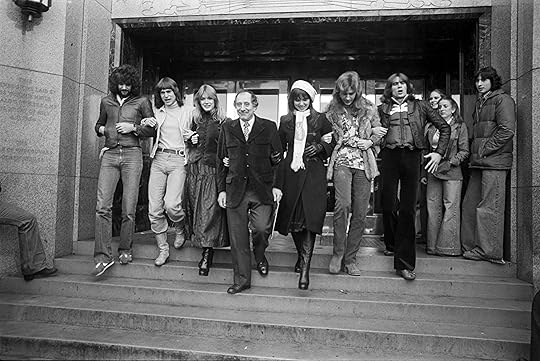 Acting Mayor Harry Rankin leads rock group Heart out of Vancouver City Hall in 1977, Deni Eagland, Vancouver Sun
Acting Mayor Harry Rankin leads rock group Heart out of Vancouver City Hall in 1977, Deni Eagland, Vancouver SunKate Bird, author of Vancouver in the Seventies and City on Edge, and a PNG librarian for 25 years, helped manage the large collection.
“When I first started in 1990 there were 20 staff members working in the library, now there is just one, and I think Carolyn Soltau is the only newspaper librarian left in Canada,” says Bird. “Over the years we tried really hard to get more public access to it—to take the digital image archive and make some of those images available online, but we never got any traction, there was no money for it.”
Bird says that in the 1970s two dozen photographers worked either for the Sun or the Province shooting over 4,000 assignments each year (that’s over 10,000 rolls of film a year).
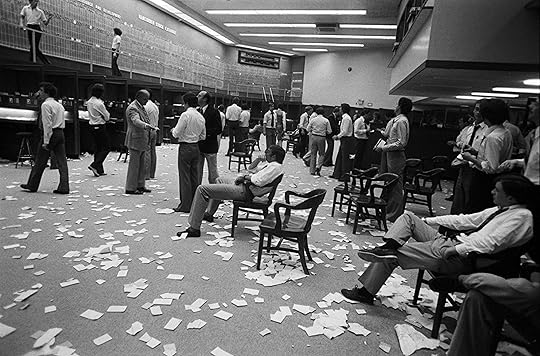 The Vancouver Stock Exchange trading floor, June 1979. George Diack, Vancouver Sun
The Vancouver Stock Exchange trading floor, June 1979. George Diack, Vancouver Sun“That’s how much stuff there is—every part of the city’s history—news, business, sports, entertainment, lifestyle, Smile of the Day—you name it.”
These days there are two photographers shooting for both dailies.
Gordon says she can’t put a value on the collection just yet, but she’ll be having it appraised later this year.
Postmedia retains the copyright, but local history writers can relax, the images will be freely available for research and news reporting. Commercial users will have to ante up to Postmedia.
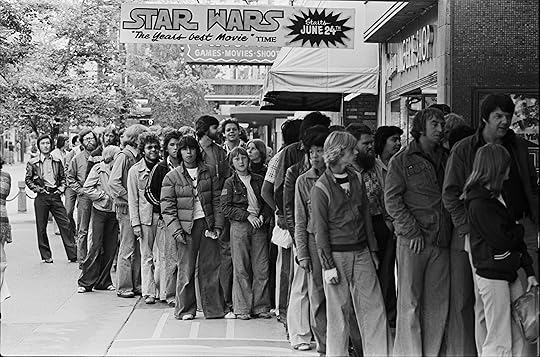 A Star Wars line-up in June 1977 at the Vogue Theatre. Glenn Baglo, Vancouver Sun
A Star Wars line-up in June 1977 at the Vogue Theatre. Glenn Baglo, Vancouver SunGordon warns that digitizing images is expensive and time consuming and it might be sometime until the collection is available to the public.
“On average our technician can scan between 80 and 100 images a day, and an archivist can describe anywhere from 100 to 200 images a day,” says Gordon. “The average cost per day is about $240 for the technician and about $330 for the archivist.”
Prior to the Postmedia donation, CVA had 130,000 images available online—roughly 8% of their collection.
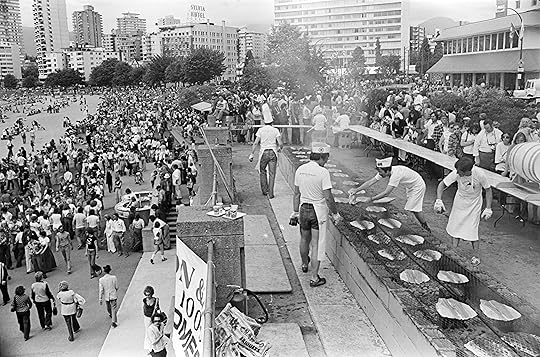 Remember the Sea Festival? Brian Kent, Vancouver Sun, July 1977
Remember the Sea Festival? Brian Kent, Vancouver Sun, July 1977Last year, thousands of photos were digitized including more than 4,300 from the City heritage inventory as well as Habitat Forum photos.
Gordon says they plan to add another 20,000 images this year which will include the Paul Yee Fonds and about 5,300 Don Coltman photos from the Williams Brothers Photographers collection.
A number of factors come into play when deciding what to digitize next, she says, including public interest in the content, physical condition, and most importantly—funding.
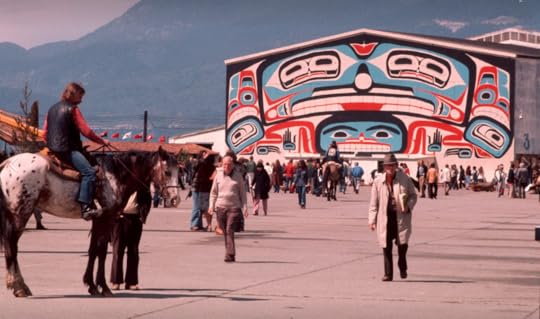 Nearly 7,000 photos from Habitat ’76 are now online. Courtesy Vancouver Archives
Nearly 7,000 photos from Habitat ’76 are now online. Courtesy Vancouver Archives“We rely mostly on grants and private-sector donations to fund our digitization program,” she says. “If someone donates toward digitizing a certain group of records, those records move up the queue.”
Want to see these images get online faster? Here’s how to help:
Make a donation or take out a membership with the Friends of the Vancouver Archives – if you’re an addict like I am it will be the best twenty bucks you’ve ever spent.
© All rights reserved. Unless otherwise indicated, all blog content copyright Eve Lazarus.

January 13, 2018
The Babes in the Woods Murder Investigation Turns 65
Sunday January 14 marks the 65th anniversary of the discovery of the Babes in the Woods. The murder of the two small children in Stanley Park is one of Vancouver’s most enduring murder mysteries and is part of Cold Case Vancouver: the city’s most baffling unsolved murders.
I caught up for dinner with my friend Laura Yazedjian this week. Laura is an identification specialist with the BC Coroners Service, which currently has 181 cases of unidentified remains on its books.
With one exception, the cases span more than 50 years—from 1962 to 2017.
Some are hikers who were lost and ultimately perished in the woods. Some were pulled from rivers and lakes around the province. Others were found in mountain crevices.
Old, young, male and female. Suicides, accidents and murders. Every case is an active investigation.
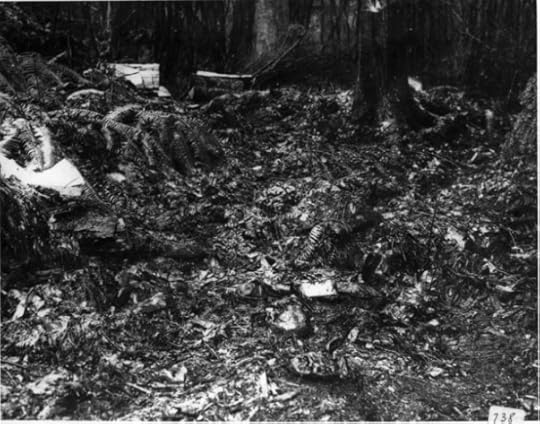 Crime scene photo, 1953. Courtesy Vancouver Police Museum
Crime scene photo, 1953. Courtesy Vancouver Police MuseumLaura’s oldest case is the Babes in the Woods, the two small children who were murdered in Stanley Park in 1947, their skeletons found six years later.
In recent years, the most promising lead in the search to discover their identities came from former VPD detective Ron Amiel. Ron who was born in 1930, lived with his grandmother in her rooming house at Bute and Davie Streets. When I interviewed him for Cold Case Vancouver, he told me that his grandmother knew Harry Cox, a signalman at the Prospect Point lighthouse, and after the war, Harry’s daughter and her two sons stayed in the rooming house. At some point the two little boys disappeared. (Their disappearance wasn’t explored at the time because detectives thought they were searching for a missing brother and sister. When DNA testing emerged in the 1990s it was discovered they were two brothers).
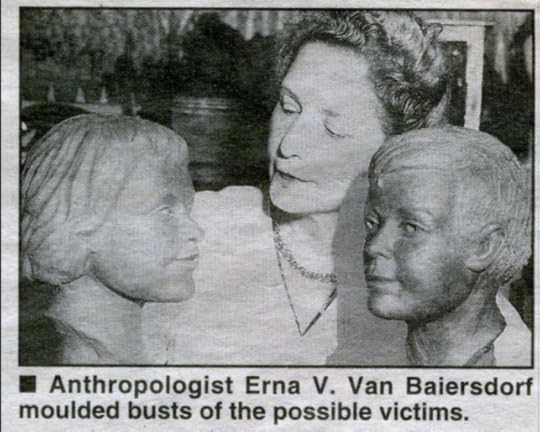
An investigation found that there was another son who died in the ‘70s, and could be a half-brother to the Babes in the Woods. In 2015 his body was exhumed and tested for mitochondrial DNA (DNA passed directly from the mother).
Unfortunately, the results were inconclusive—there wasn’t enough DNA for a match.
Sometimes Laura has a full body to work with, sometimes just a bone. In the case of the Babes in the Woods all she has are two tiny skulls. That’s a problem when deciding what to test, because DNA is finite–she has to be careful it doesn’t run out.
The other problem is that while new techniques are available, they are expensive. Each DNA test costs the coroner’s office $600, while mitochondrial DNA costs six times that.
“Testing for mitochondrial DNA is really expensive,” says Laura. “We have to send it out because the lab we use at BCIT doesn’t do it so there has to be a real possibility of a result.”
Before signing on as a coroner in 2013, Laura, whose specialty is forensic anthropology, worked in Bosnia for 10 years identifying some of the thousands of people who were massacred during the Balkans war and dumped in mass graves.
In 2015, the Coroner’s office sent 24 samples from cold cases to a lab in Bosnia that had advanced testing procedures. Twenty-one results came back and they closed seven cases.
“That was incredibly satisfying,” says Laura, adding that the lab at BCIT now uses some of the techniques developed by the Bosnian lab.
That will come in handy in the future, because while whoever murdered the two little boys in Stanley Park is likely long dead, Laura remains optimistic that one day we’ll be able to give them back their names.
© All rights reserved. Unless otherwise indicated, all blog content copyright Eve Lazarus.

January 6, 2018
Saving History: The Rec Room and the Player Piano
By Michael Kluckner
Michael Kluckner is a writer and artist with a list of books that includes Vanishing Vancouver and Toshiko. His most recent book is a graphic novel called 2050: A Post-Apocalyptic Murder Mystery. He is the president of the Vancouver Historical Society and a member of the city’s Heritage Commission.
We inherited a player piano when we bought our house in 2010. It’s a long story, but in the back of my mind I thought I might want to play it. As it turned out I didn’t, but try to find a new home for an old piano nowadays!
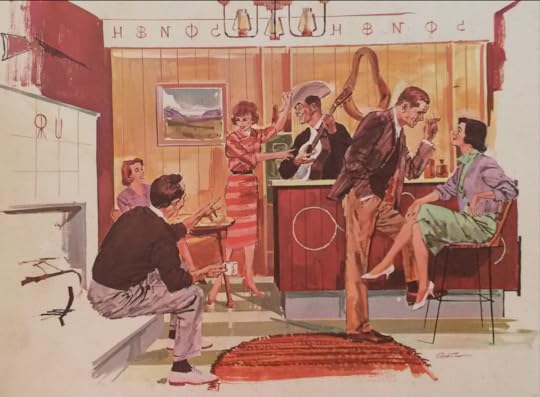 Entertaining in a Western-themed rec room. Published by Canadian Forest Products, 1961. Courtesy Michael Kluckner
Entertaining in a Western-themed rec room. Published by Canadian Forest Products, 1961. Courtesy Michael KlucknerOur hundred-year-old Grandview house also contained a postwar classic—a panelled “rec room” in the basement where the piano lived. They were so popular that Canadian Forest Products’ New Westminster plywood division published a plan book in 1961, offering homeowners six themes to choose from—Contemporary, Western, Polynesian, Tavern, (Artist’s) Salon, and Marine. This was an era of casual entertaining at home, dancing to LPs on the hi-fi or watching TV and drinking. Three of the six plans include a bar.
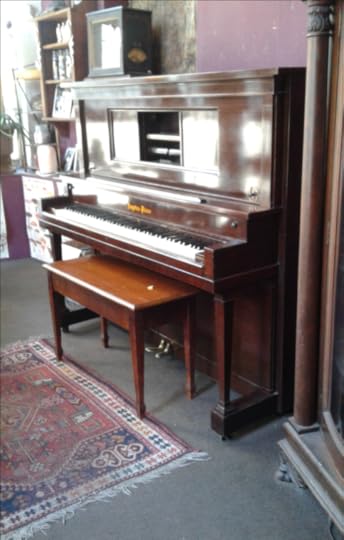 The player piano’s temporary home at Salmagundi West
The player piano’s temporary home at Salmagundi WestOur player piano came with dozens of music rolls—popular arrangements of classics and some show tunes like The Sound of Music. As most readers will know, the piano “plays itself,” powered by a “pianist” who pumped on foot pedals, causing the perforated roll to pass over a drum and triggering an ingenious multitude of cogs and arms that made the hammers hit the strings in the correct order.
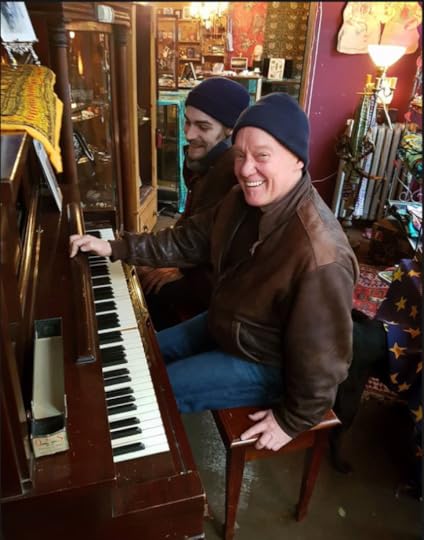 Musicians Adam Farnsworth and Tom Carter take the player piano for a spin at
Musicians Adam Farnsworth and Tom Carter take the player piano for a spin atSalmagundi. Photo Diane Farnsworth, December 2017.
Player pianos are classic Victoriana, a great example of that era’s fascination with complex gizmos like steam engines. A skilled pianist could actually play accompaniment to the piano-roll tune; more likely, most people pedalled away, watched the keys go up and down, and sang along. It probably made its way to our house in the ’50s.
After years of trying, we had all but given up finding the piano a new home, but then Tom Carter joined the board of the Vancouver Historical Society. Tom is a musician and artist with a keen interest in entertainment history. He came over and saw it, got it playing, hired a rebuilder to fix it up, and said he would love to have it—the only problem being that he already has a grand piano in his home.
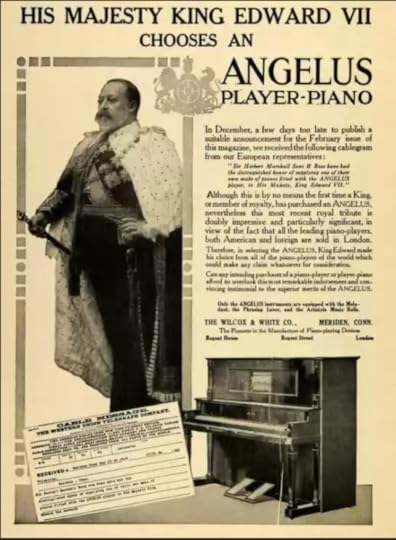 Courtesy Tom Carter
Courtesy Tom CarterNo problem, he said, he’d find it a home.
Along the way, Tom researched its history. It’s an Angelus, probably from 1915–20. New, it was worth about $950, or double the price of a Model T Ford and about equivalent to the annual income of a skilled tradesman.
Watch and listen here: tomhighres
Player pianos were the home-entertainment centre of the day, a kind of transition between the skilled pianist (usually a woman) of 19th-century family gatherings to the hi-fi and, in this era, the TV that has now become the home theatre.
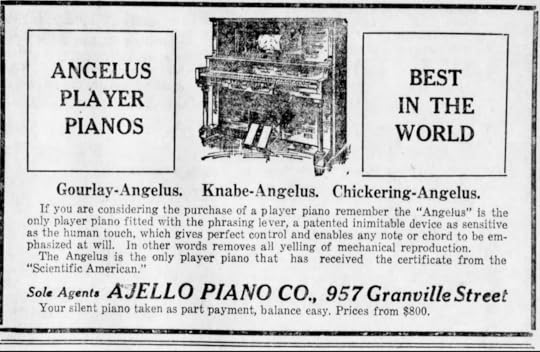
At the time of writing, the player piano was living at Salmagundi on West Cordova in Gastown. But last month, after 45 years in business, proprietor Anne Banner had the lease terminated and will be vacating the premises at the end of this month. The piano will be going to another temporary home in White Rock where it will be restored and rebuilt. EL

December 1, 2017
Top 10 History Blogs for 2017
For my last post of 2017, I have compiled a list of my favourite history blogs. To make the list, the blog had to written by an individual and have a strong Metro Vancouver flavor.
In alphabetical order:  1. A Most Agreeable Place
1. A Most Agreeable Place
Lana Okerlund, a Vancouver book editor and writer, has put together this quirky little blog about bookstores past and present. And who doesn’t love a bookstore? It’s full of facts. For instance did you know a copy of Robinson Crusoe, Gulliver’s Travels or Don Quixote would cost you 60 cents in 1887?

This is one of my go to sites when I’m looking up an architect or building. John Atkin is behind this blog of before and after photos divided into still standing, gone and altered with archival photos from the Vancouver Archives, BC Archives and special collections at Vancouver Public Library. I love how the blog includes a section on how the image was made.
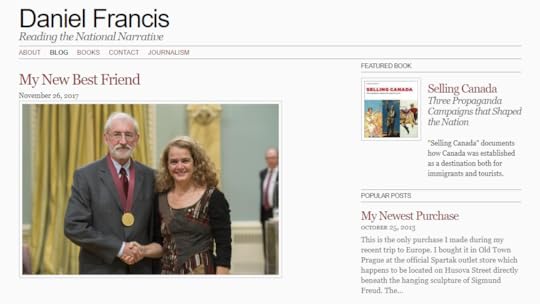
Dan Francis just collected the Governor General’s History Award for Popular Media in Ottawa last month. That’s a big deal and I can’t think of anyone more deserving. There are 15 books listed on his website (everything from the history of trucks to brothels). I especially like Dan’s personal touch with posts such as the one about how he met his nanny—66 years later.

Yes, this is my blog which I’ve been writing obsessively since 2011. It’s an outlet for my passions of local history, heritage houses and murder, and lets me try out ideas for future books, have fun with photos, or just gives me an excuse to look up cool stuff. It also acts as a companion to my Facebook page of the same name.

Jason Vanderhill stopped writing his blog in 2015 when he reached a staggering 1,000 posts. I’ve included it because it’s an amazing resource for anyone with an interest in Vancouver’s art history. You’ll find work from artists like BC Binning, contemporary artists such as Tom Carter, and stuff you never knew about such as 1930 plans for a museum at Dead Man’s Island.

6. Janet Nicol
Janet is a former high school history teacher turned writer, who according to her blog, has notched up more than 340 articles in 44 magazines and journals. She writes on BC history, social justice issues and art. And if you can’t afford a subscription to BC History, Janet often posts her articles on this blog.

7. Past Tense
Lani Russwurm gets my vote for the most knowledgeable history guy in the city. His blogs are always entertaining, highly researched, and I’m forever learning something new and wishing that I’d thought of it first. As well as his Past Tense blog, Lani wrote Vancouver was Awesome and is behind the Forbidden Vancouver blog.

I’m seriously intimidated by Angela Eidinger’s qualifications. She has a BA in history from McGill, a doctorate of philosophy in history from UVic, and is currently teaching at UBC. Angela does a roundup of history news each week, and has a great list of resources on her site such as the Canadian Historians Guide to Twitter and a Holiday Gift Guide for Historians.

9. Vanalogue
Christine Hagemoen is the force behind this excellent blog. She has worked as a media librarian for the CBC and an archival assistant at Vancouver Archives and really knows her stuff. Subject material ranges from Sara Cassell’s East Georgia Street café to the date stamps in concrete sidewalks to bottle dash stucco.

10. Vancouver as it was: a photo historical journey
Murray Maisey’s blog is much more than photos, he really delves into the history of whatever he is researching. I like the way he “talks” to himself in his stories. In a post about the long defunct Empire Building he writes: “A question which often arises in my mind with such structures is “Who were the tenants who occupied it?…So I dug into Vancouver directories.”
If you are in need of a little more history in your holidays try these posts from the last two years:
The Top 10 Facebook History pages for 2015
The Top 10 Facebook Group Pages for 2016
Have I missed your favourite Vancouver history blogger? Leave me a comment and I’ll make sure to check them out. And, thanks for following my blog!
© All rights reserved. Unless otherwise indicated, all blog content copyright Eve Lazarus.




